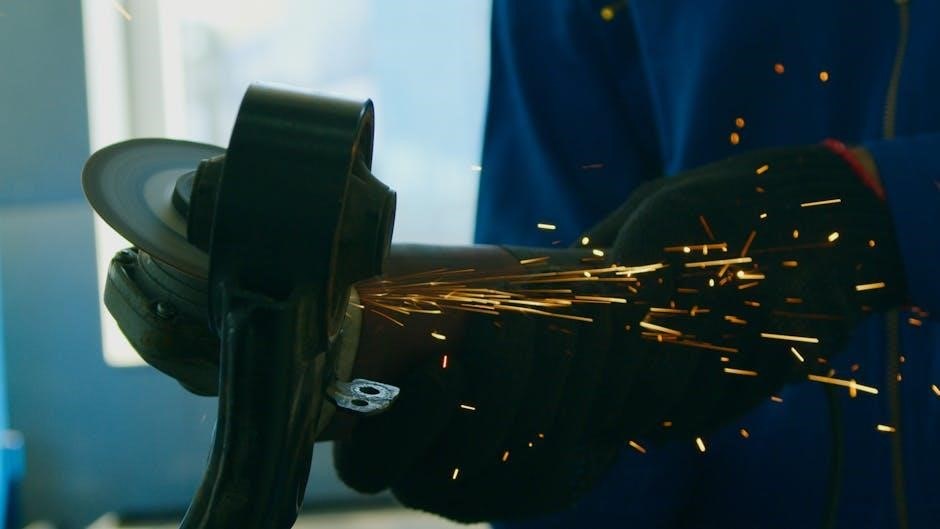This manual provides a comprehensive guide to understanding and using the Blue Ox Weight Distribution Hitch, ensuring safe and efficient towing experiences with proper setup and maintenance․
1․1 Overview of the Blue Ox Weight Distribution Hitch
The Blue Ox Weight Distribution Hitch is designed to enhance towing stability and safety by evenly distributing the weight of the trailer across the vehicle․ Built with durability and ease of use in mind, it features high-quality components and innovative engineering․ Its weight distribution system ensures a smooth towing experience, reducing sway and improving control․ Suitable for various vehicle and trailer combinations, the hitch is a reliable choice for both novice and experienced tower operators․ This manual provides detailed guidance to help users maximize its performance and ensure a secure connection․
1․2 Importance of Proper Hitch Installation and Setup
Proper installation and setup of the Blue Ox Weight Distribution Hitch are crucial for ensuring safety, stability, and optimal performance․ Incorrect installation can lead to uneven weight distribution, reduced control, and potential safety hazards while towing․ By following the manual’s guidelines, users can achieve a secure connection, minimize sway, and maximize the hitch’s efficiency․ Regular inspections and adjustments are also essential to maintain proper function and extend the lifespan of the hitch․ Proper setup ensures a smooth towing experience and protects both the vehicle and trailer from unnecessary strain․

Key Features and Benefits of the Blue Ox Weight Distribution Hitch
The Blue Ox Weight Distribution Hitch offers superior weight distribution, enhanced stability, and durability․ Its innovative design ensures a smooth towing experience and minimizes trailer sway, providing safety and control․
2․1 Components of the Blue Ox Weight Distribution Hitch
The Blue Ox Weight Distribution Hitch consists of a durable hitch head, adjustable spring bars, a shank, and a sway control system․ These components work together to distribute weight evenly between the trailer and towing vehicle, enhancing stability and control․ The hitch head is designed for strength and flexibility, while the spring bars adjust to varying weight loads․ Additional features include a ball mount and friction sway control, ensuring a smooth and secure towing experience․ Each part is engineered for longevity and ease of use, making it a reliable choice for heavy-duty towing applications․
2․2 Advantages of Using a Weight Distribution Hitch
A weight distribution hitch offers enhanced stability and control while towing, reducing trailer sway and improving overall safety․ It ensures proper weight distribution, preventing excessive strain on the tow vehicle’s rear axle․ This system promotes even weight distribution between the vehicle and trailer, enhancing braking performance and handling․ By minimizing wobble and instability, it provides a smoother towing experience, especially in windy or uneven road conditions․ Additionally, it helps maintain consistent ground clearance, ensuring optimal trailer height for safe and efficient towing․ These benefits make it an essential accessory for heavy-duty towing applications․

Pre-Installation and Setup Requirements
Ensure vehicle and trailer compatibility, gather necessary tools, and review specifications before installation․ Support and resources are available through Patreon communities for guidance․
3․1 Vehicle and Trailer Compatibility Check
Ensuring compatibility between your vehicle and trailer is crucial for safe towing․ Verify the vehicle’s towing capacity and trailer’s weight rating to avoid overload․ Check axle types, frame construction, and electrical connections․ Proper alignment and mounting points are essential for stability․ Always refer to manufacturer guidelines for specific recommendations․ Compatibility checks prevent potential safety hazards and ensure optimal performance of the Blue Ox Weight Distribution Hitch․ Use official resources or consult professionals if unsure․
- Verify towing capacity and weight ratings․
- Inspect axle types and frame durability;
- Check electrical and braking system compatibility․
3․2 Tools and Materials Needed for Installation
Installing the Blue Ox Weight Distribution Hitch requires specific tools and materials to ensure a secure and proper setup․ Essential tools include a torque wrench, socket set, wrenches, and a measuring tape․ Materials needed are the hitch components, bolts, washers, and locking pins․ Lubricants for moving parts and blocks or jack stands for vehicle support are also necessary․ Electrical connectors and a trailer ball complete the list․ Having all tools and materials ready ensures a smooth installation process․
- Socket set and wrenches
- Torque wrench
- Measuring tape
- Bolts, washers, and locking pins
- Lubricants
- Jack stands or blocks
- Electrical connectors
- Trailer ball

Step-by-Step Installation Guide
Follow a detailed, sequential process to install the Blue Ox Weight Distribution Hitch, ensuring safety and proper alignment․ Start with hitch mounting, proceed to spring bar attachment, and finalize with sway control setup for optimal stability and performance․
- Mount the hitch to the vehicle
- Attach spring bars and sway control
- Adjust and tighten all components
- Test the setup for stability
4․1 Mounting the Hitch to the Vehicle
Mounting the Blue Ox Weight Distribution Hitch to your vehicle is the first critical step in the installation process․ Ensure the vehicle’s hitch receiver is clean and free of debris․ Attach the hitch by aligning the shank with the receiver and securing it with the provided pin and clip․ Tighten all bolts firmly, following the torque specifications outlined in the manual․ Double-check the alignment to ensure the hitch is level and properly seated․ Finally, test the connection by gently tugging on the hitch to confirm it is securely fastened․
- Align the hitch shank with the receiver
- Secure with the provided pin and clip
- Tighten bolts to specified torque
- Verify alignment and test the connection
4․2 Attaching the Spring Bars and Sway Control
After mounting the hitch, attach the spring bars to the hitch head, ensuring they are properly seated in the designated slots․ Secure them with the provided U-bolts, tightening them evenly to distribute weight correctly․ Next, install the sway control bracket to the hitch and attach the sway control arm to the trailer frame․ Align the arm to reduce sway and tighten all connections firmly․ Double-check all bolts and ensure the system is balanced for safe towing․ Proper alignment and secure fastening are crucial for optimal performance and safety․
- Secure spring bars in hitch slots
- Attach sway control to trailer frame
- Tighten all connections evenly
- Ensure proper alignment for stability

Adjusting and Fine-Tuning the Hitch
Adjust the ball mount height to ensure the trailer is level, then fine-tune the spring bars for even weight distribution․ Check the hitch angle and tension for optimal stability and performance․
- Level the trailer
- Adjust spring bar tension
- Ensure proper hitch angle
5․1 Setting the Proper Ball Mount Height
Setting the correct ball mount height ensures proper trailer leveling and weight distribution․ Measure the distance from the vehicle’s hitch to the top of the ball mount․ Adjust the ball mount height so the trailer sits level when connected․ Loosen the adjustment bolt, then raise or lower the mount as needed․ Tighten securely and double-check the levelness of the trailer․ Proper height alignment improves towing stability and prevents uneven weight distribution, which can affect handling and safety on the road․
- Measure hitch height accurately
- Adjust ball mount for level towing
- Ensure secure tightening
5․2 Adjusting the Spring Bars for Weight Distribution
Adjusting the spring bars is crucial for balancing weight between the vehicle and trailer․ Attach the spring bars to the hitch and measure the gap between the bars and their brackets․ Tighten the chains firmly, ensuring even weight distribution․ Proper tension prevents swaying and enhances stability․ Use a torque wrench to secure the bolts according to the manufacturer’s specifications․ Regularly check and adjust the spring bars to maintain optimal weight distribution and towing performance․ Correct adjustment ensures a smooth and safe towing experience․
- Attach spring bars to the hitch
- Measure and adjust chain tension
- Secure bolts with proper torque

Maintenance and Upkeep of the Hitch
Regular maintenance ensures optimal performance and longevity․ Inspect all components for wear, lubricate moving parts, and tighten bolts to specified torque values․ Schedule annual professional inspections to ensure safety and reliability․
6․1 Regular Inspection of Hitch Components
Regular inspections are crucial for ensuring the hitch operates safely and efficiently․ Examine the spring bars, bolts, and connections for wear or damage․ Check the ball mount and hitch receiver for proper alignment and integrity․ Look for signs of rust or corrosion on all metal parts․ Inspect the sway control components for any deformation or excessive wear․ Perform these checks before each use and annually by a professional to maintain optimal performance and safety․ Cleaning the hitch regularly helps prevent dirt buildup that could lead to premature wear․
6․2 Lubrication and Torque Specifications
Regular lubrication is essential for maintaining smooth operation and preventing corrosion․ Apply grease to moving parts like the hitch ball and spring bar ends․ Ensure all bolts and nuts are tightened to the specified torque values, as outlined in the manual․ Proper torque ensures stability and safety while towing․ Always use the recommended lubricants and tools to avoid damage․ Blue Ox specifies exact torque ratings to prevent under-tightening or over-tightening, which can lead to component failure․ Follow these guidelines to maintain optimal performance and extend the hitch’s lifespan․

Troubleshooting Common Issues
This section helps identify and resolve common problems, such as sway issues, uneven weight distribution, or noise, ensuring safe and efficient towing with the Blue Ox hitch․
7․1 Addressing Sway and Stability Problems
Sway and stability issues can arise from improper weight distribution or hitch setup․ Ensure the trailer tongue weight is 10-15% of the trailer’s total weight․ Adjust the spring bars to distribute weight evenly between the vehicle and trailer axles․ Check the ball mount height to ensure it’s level when connected․ If sway persists, consider using sway control accessories․ Avoid sudden maneuvers and maintain a moderate speed․ Regularly inspect the hitch components for wear or damage․ Proper adjustment and maintenance can significantly improve towing stability and reduce sway․
7․2 Solving Noise or Vibration Issues
Noise or vibration issues with the Blue Ox hitch often result from improper installation or lack of maintenance; Ensure all bolts and nuts are tightened to the specified torque values․ Lubricate the hitch ball and moving parts with a silicone-based spray to reduce friction and noise․ Check for loose components, such as spring bar clips or sway control brackets, and secure them firmly․ If vibrations persist, verify that the hitch is properly aligned with the trailer and vehicle․ Regular maintenance and inspection can prevent these issues and ensure smooth towing performance․

Accessories and Upgrades for the Blue Ox Hitch
- Enhance performance with optional sway control units and heavier spring bars for larger trailers․
- Upgrade to specialized hitch balls or covers for added durability and weather protection․
- Consider locking mechanisms for securing the hitch and preventing theft during storage․
8․1 Optional Accessories for Enhanced Performance
To maximize the functionality of your Blue Ox Weight Distribution Hitch, consider adding optional accessories․ Sway control units and heavy-duty spring bars can improve stability for larger or uneven loads․ Anti-sway brackets and friction pads reduce trailer movement, while weighted hitch balls enhance durability․ Hitch covers and protective coatings shield components from rust and wear․ Additionally, electronic hitch monitors and load-leveling tools offer real-time feedback for optimal towing․ These accessories ensure a smoother, safer towing experience and extend the hitch’s lifespan․ Always choose parts compatible with your Blue Ox system for seamless integration․
8․2 Upgrading to Heavy-Duty or Specialty Hitches
For heavy-duty towing needs, upgrading to a specialty Blue Ox hitch can provide enhanced performance․ Heavy-duty models are designed for larger trailers or extreme conditions, offering increased weight capacity and durability․ Specialty hitches, such as gooseneck or fifth-wheel adapters, cater to specific towing requirements․ Upgrading ensures better stability and control for heavy loads․ Consider your towing frequency and load size when selecting an upgrade․ Always consult professionals or refer to the Blue Ox manual for compatibility and installation guidelines to ensure a safe and efficient upgrade process for your towing setup․

Safety Considerations and Best Practices
Safety is crucial when using a weight distribution hitch․ Always follow installation guidelines, conduct regular inspections, and ensure proper load balance to maintain safe towing conditions․
9․1 Safe Towing Practices with a Weight Distribution Hitch
Safe towing practices are essential to ensure stability and control․ Always maintain a safe speed, especially on uneven roads, and avoid sudden maneuvers․ Use trailer brakes appropriately and ensure the load is evenly distributed․ Regularly check tire pressure and hitch connections before and during trips․ Keep a safe distance from other vehicles and be aware of weather conditions that may affect towing stability․ Proper use of mirrors and trailer visibility aids can enhance safety․ Adhere to the manufacturer’s guidelines for weight limits and towing capacities to prevent accidents․ Proper setup and maintenance are critical for safe towing experiences․
9․2 Pre-Trip Checks and Load Balancing
Before each trip, perform a thorough pre-trip inspection of the hitch and trailer․ Ensure the coupler is securely attached to the ball mount, and all bolts are tightened to the specified torque․ Verify that the spring bars are properly engaged and adjusted for even weight distribution․ Check the trailer’s tire pressure and load balance, ensuring the tongue weight is 10-15% of the trailer’s total weight․ Secure all cargo evenly and test the brakes and lighting systems․ Proper load balancing and pre-trip checks ensure a stable and safe towing experience, reducing the risk of swaying or losing control․

Frequently Asked Questions (FAQs)
This section addresses common queries about the Blue Ox hitch, including installation, usage, and troubleshooting, providing clear solutions for optimal performance and safety․
10․1 Common Questions About Installation and Use
Users often ask about installation challenges, such as aligning the hitch ball and torque specifications․ Questions also arise about the weight capacity, proper sway control adjustment, and whether the hitch works with surge brakes․ Many inquire about the tools needed, such as a torque wrench, and the time required for installation․ Additionally, some seek clarity on whether the hitch can be used with different trailer setups or if it’s compatible with lift kits․ Always refer to the manufacturer’s guidelines for precise instructions and safety precautions to ensure optimal performance and warranty validity․
10․2 Warranty and Customer Support Information
The Blue Ox Weight Distribution Hitch is backed by a limited lifetime warranty, covering defects in materials and workmanship․ The warranty is non-transferable and applies to the original purchaser only․ For any issues, Blue Ox offers dedicated customer support via phone or email․ Their team assists with troubleshooting, warranty claims, and general inquiries․ Additional resources, such as product manuals and FAQs, are available on their official website․ Customers can also contact authorized dealers for further assistance, ensuring comprehensive support for optimal hitch performance and longevity․
The Blue Ox Weight Distribution Hitch Manual provides comprehensive guidance for installation, setup, and maintenance, ensuring optimal performance and safety; Proper use enhances towing stability and longevity, supported by reliable customer service and warranty coverage for a secure investment․
11․1 Summary of Key Points
The Blue Ox Weight Distribution Hitch Manual emphasizes proper installation, setup, and maintenance for optimal performance and safety․ It highlights the importance of vehicle-trailer compatibility, correct ball mount height, and spring bar adjustment․ Regular inspections, lubrication, and torque checks ensure longevity․ Addressing sway and noise issues through fine-tuning enhances towing stability․ Safety practices, pre-trip checks, and load balancing are stressed for secure hauling․ With accessories and upgrades available, the hitch offers versatility․ Customer support and warranty provide additional assurance, making it a reliable choice for towing needs, backed by comprehensive guidance for enhanced performance and user confidence․
11․2 Final Tips for Optimal Hitch Performance
For optimal performance, regularly lubricate all moving parts and ensure proper torque specifications are met․ Always double-check spring bar tension and sway control alignment before towing․ Maintain even load distribution in the trailer and monitor the hitch system during trips․ Schedule periodic professional inspections to identify potential wear․ Store the hitch in a dry, protected area when not in use․ By following these tips and adhering to the Blue Ox manual, you can maximize the hitch’s efficiency, safety, and lifespan while ensuring smooth towing experiences every time․
